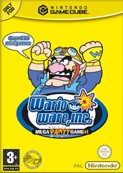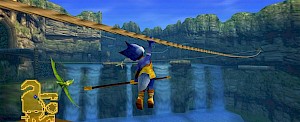Review: WarioWare Inc: Mega Party Games
Posted 15 Sep 2004 at 23:09 by Bas van der Burgh
Reviewing Wario Ware puts the reviewer in a difficult position. Judge the game strictly on what it is, or on what it could have been?
The problem is as follows: the original Wario Ware for Game Boy Advance is a brilliant game. Since the GameCube version is largely the same as its GBA counterpart, it's logical to assume Wario on GC also rocks. And it does. Very much so indeed. However, it's not unreasonable to expect something more from a game for a platform capable of so much more than a GBA, is it?


An introduction to Wario Ware:
First things first. For those of you lucky enough to still have the whole Wario Ware experience ahead of you, a short explanation of the game will follow. Experienced Wario-modellers, frog-counters, paper plane pilots and airbag deplorers can skip this part and move on to the next section. Those who still have absolutely no idea what they're supposed to do can also stay.
The game consists of over 200 simple games, which each last about three seconds. A game appears on the screen with an indication of how to complete the task. For example: you see Wario sitting at a counter and the onscreen text says "Catch!" Just as you want to pick up the manual what the heck this game is about, a glass of beer slides over the bar and disappears from the screen and the game tells you that you have just lost one of your lives. Before you have put down the controller, a second game appears. A bunch of pixels comes skiing from a mountain towards a ramp accompanied by the text "Jump!" Intuitively you press the A-button, but you're too late and pixelman crashes miserably on the slope: one life remaining.


As the above illustrates, it's likely your first session won't be a long one, but some gamer's instinct and some practice will get you there. Part of the fun is to find out how to play the microgames. When you master most of them, the challenge comes from the increasing speed of the game. As videogames grow increasingly elaborate and complex, Wario Ware offers the opposite with a bunch of simple games which require one button and a d-pad ad maximum. The wackiness of the games and the camp visual style of some of them make for an edgy gaming experience I hadn't expected from Nintendo. It's a bit weird at first, but many learn to appreciate the original gameplay. If you have played a lot of older (Nintendo) games, this is also a nostalgic trip.
Nintendo's Port-a-tron 3000 TM:
It seems to me Nintendo have invested in a machine that ports software from one platform to another. Judging from Nintendo's output in the last ten years, the machine seems to have been an expensive purchase, as they seize every opportunity to earn it back. It's a decent piece of machinery as well; after Super Mario All-Stars, the wagonload of GBA-ports and the highly overpriced NES classics, it's still working. Instead of redesigning Wario Ware for the GameCube, Nintendo decided to shove the game through their porting machine. The games are not completely identical, though. The GC version has two advantages.
The first is that the game can now be played on a big screen with a GC controller – without having to buy a Game Boy player! This means it's easier on the eye for owners of the traditional GBA and reduces the chance on RSI for GBA SP owners. It's less portable of course, and as Wario Ware is perfectly suited for shot sessions of handheld gaming, I guess the increased comfort comes at a price. The other extra feature is the inclusion of a multiplayer mode. We'll come to that shortly.


For the rest there are hardly any changes. The GC version has new – less artistic – menus and some of the useless cut scenes have been deleted, but that's about it. The microgames look exactly the same, and though the lo-res blurry imagery suites some of the games' styles, it often looks rather cheap. Because stretching the image further would make the visuals too vague, the game is not full screen. With the GC's power, the existing games could have had a makeover, and I'm sure new games could have been designed. Still only a handful of the microgames use some 3D effects, so a whole new area of wacky minigames is practically left untouched. The upcoming GBA sequel – with a motion sensor built in the cartridge – and DS version – which will use the touch screen and dual screen functions – are therefore more interesting prospects than Wario Ware for Nintendo's most powerful machine.
[pagebreak]
About the multiplayer modes:
The multiplayer mode doesn't really feature new games, but puts the existing games in a multiplayer context. For example: one player plays the microgames, while others walk through the screen to block his vision. The opposite of this mode is the game where one person plays the games on a dark screen and the other players have flashlights to help him finish as many games as possible. Other modes allow players to compete by taking turns or play simultaneously. One of the best modes is playing Othello, where spaces are being earned by winning a couple of fast minigames. Most original is the mode where you have to complete games while performing a task like raising an eyebrow or looking at the player on your left. It pays off to do so, as the other players can give feedback by clapping their hands (in game that is).


Two survival games can be played with a maximum of sixteen players (and one controller). When someone loses, he's out of the game. Only two modes allow players to battle in the same minigame: racing with paper planes and jumping over a rope with four players simultaneously. Overall the multiplayer can be very funny – not much of a surprise considering the game it's based on –, but don't expect anything new.
Final say: buy or not?:
If you have never experienced the delights of Wario Ware before, and feel like playing something different, I highly recommend you give it a try. Whether you should buy the GBA or GC version depends on your preferences: it's portability versus multiplayer. If you're indifferent; the GC version is supposed to be priced at player's choice level.


If you already played the GBA original, the game offers little to justify another purchase. If you really like it, and have a friend – but preferably two or three – that like Wario Ware; the hilarious multiplayer may well be worth the money.
Though there were plenty of opportunities to make Wario Ware more than it already is, the mark below is for what the final product has become. It feels unfair to lower the grade only because the game is now also available on another platform which accidentally has more potential than the one it was released on in the first place. A nine with a funny taste it is, then.
N-Europe Final Verdict
A lazy port of a brilliant game, but it is just that.
- Gameplay5
- Playability5
- Visuals4
- Audio4
- Lifespan4
Final Score
9
Pros
Crazy, artistic games
Hilarious multiplayer
Truly original
Cons
Uses 10% of the GC's power
Hardly any new minigames
























